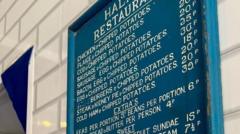What Does a 20p Fish and Chips Menu from the Past Reveal?

Unveiling the Nostalgia of Fish and Chips: A Journey Through Time
For over fifty years, a dust-covered price board lay hidden in a garage, echoing the past of one of Wales' oldest family-run fish and chip shops. This board, recently discovered by Andrew Lewis, the third-generation owner of Evans Plaice in Rhayader, serves as a fascinating time capsule, capturing a snapshot of British culinary history. With a humble portion of cod and "chipped potatoes" once priced at a mere 20p, this relic sparks memories of a time when fish and chips were not just a meal, but a cherished tradition. As we delve into the significance of this find, we unravel the evolution of fish and chips, the changing landscape of food prices, and the enduring charm of this beloved British dish.
The Historical Significance of the Price Board
The price board, believed to date back to around 1971, emerges as a poignant reminder of the British decimalisation of currency. Transitioning from shillings and pence to a more straightforward decimal system, the board encapsulates a pivotal moment in British history. It reflects the economic landscape of the era, where diners could enjoy a two-course meal, including a slice of bread and butter, for just 45p. Mr. Lewis’ discovery has sparked curiosity and nostalgia among locals and visitors alike, emphasizing the enduring legacy of the family business.
A Family Legacy
Evans Plaice, originally established as Halten Restaurant by Edgar and Megan Evans in 1950, has been a staple of the Rhayader community for generations. After passing through the hands of Mr. Lewis’ uncle and aunt, the restaurant found its way to Andrew Lewis, who took over in 2001. His commitment to preserving the family heritage is evident in his passion for the shop and its history.
“It’s a sentimental place for me,” says Mr. Lewis. “All the kids have spent some time working in there, either chipping, frying, or serving.” This familial connection adds a personal layer to the shop, transforming it from a mere business into a cherished part of the town's collective memory.
The Rise of Food Prices: A Historical Perspective
As we reflect on the past, it’s impossible to ignore the staggering rise in food prices over the decades. Recent data from the Office for National Statistics (ONS) shows that fish and chips have seen the largest price increase among popular takeaways. In just five years leading up to July 2024, the average cost of a portion skyrocketed by over 50%, now nearing £10. This dramatic shift invites a closer look at the factors contributing to the inflation of food prices.
Factors Influencing Price Increases
Several intertwined factors have led to the current state of rising food costs:
- Energy Costs: The surge in energy prices has significantly affected food production and preparation costs.
- Tariffs on Seafood Imports: As a nation reliant on seafood imports, tariffs and trade agreements play a critical role in pricing.
- Climate Change: Extreme weather conditions have severely impacted potato harvests, a key ingredient in fish and chips.
- Staffing Costs: Increased wages and staffing shortages have further strained operational budgets for many businesses.
These challenges have created a “perfect storm” for chip shop owners like Mr. Lewis, who have had to raise prices multiple times in recent years. “We hate doing it, but what can you do?” he says, emphasizing the difficult decisions that business owners must make as costs continue to rise.
The Enduring Popularity of Fish and Chips
Despite the rising costs, fish and chips remain a beloved British classic. Whether enjoyed around the dinner table on a Friday night or savored by the seaside, this dish holds a special place in the hearts of many. Mr. Lewis notes, “We have diversified over the years with other items, but fish and chips still have that firm place in people’s hearts.”
A Meal Beyond Price
The affordability of fish and chips was once a hallmark of British culinary culture. Today, a family of four can expect to pay nearly £50 after adding sides like mushy peas or curry sauce. Yet, the experience of enjoying fish and chips transcends mere cost. It is about the tradition, the community, and the memories created around the table.
Mr. Lewis reflects on the sentimental value of the shop: “I love working in there. You’re frying right there in front of people and chatting to all the customers. It’s great.” This connection between the staff and customers fosters a sense of community, making each meal an experience rather than just a transaction.
Celebrating 75 Years of Evans Plaice
This year marks the 75th anniversary of Evans Plaice, a milestone that underscores the restaurant’s enduring legacy. As Rhayader's iconic chip shop, it has weathered the storms of changing economic climates, evolving culinary trends, and shifting consumer preferences. The longevity of Evans Plaice is a testament to the resilience of family businesses and their ability to adapt while staying true to their roots.
Modern Adaptations in a Traditional Setting
While the core offering of fish and chips remains, Evans Plaice has embraced modernity by diversifying its menu. This strategy not only caters to changing tastes but also ensures the restaurant remains relevant in an increasingly competitive market. However, the quintessential fish and chips continues to shine as the star attraction, embodying the essence of British cuisine.
Conclusion: A Legacy Worth Preserving
The discovery of the forgotten price board at Evans Plaice serves as a powerful reminder of the rich history behind one of Britain’s most iconic dishes. It invites us to reflect on the past, appreciate the present, and consider the future of fish and chips in a changing world. As food prices continue to rise, the importance of preserving the legacy of traditional dishes becomes ever more crucial.
As you enjoy your next portion of fish and chips, think about the journey it has taken from the fryer to your plate. Will you continue to cherish this beloved dish and its history, even as prices change? The essence of fish and chips lies not just in its taste but in the memories and stories that accompany it.
FAQs About Fish and Chips
What are the origins of fish and chips?
Fish and chips originated in the UK in the 19th century, gaining popularity as a convenient and affordable meal for the working class. The dish combines battered and fried fish, usually cod or haddock, with deep-fried potatoes.
Why have fish and chip prices risen so dramatically?
Prices have increased due to various factors, including rising energy costs, tariffs on seafood imports, climate change affecting potato harvests, and increased staffing costs.
Is fish and chips still popular in the UK?
Yes, fish and chips remain a beloved British dish, enjoyed by families and individuals alike. Its enduring popularity is rooted in tradition, nostalgia, and the communal experience of sharing a meal.
As we reflect on the history and future of fish and chips, one question remains: how will the next generation embrace this culinary tradition amidst changing times? #FishAndChips #BritishCuisine #CulinaryHistory
Published: 2025-06-28 20:58:06 | Category: wales



